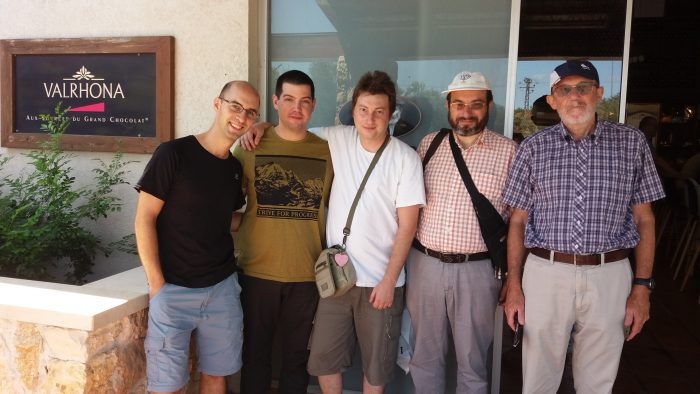Jul 10 2017
For the very first time, Researchers from the Technion-Israel Institute of Technology and Germany have demonstrated the phenomena of shape memory and self-healing in gold microparticles.
The discovery, achieved through defects-mediated diffusion in the particle, will one day lead to the development of nano and micro robots capable of self-repair; damage-tolerant and mechanically stable devices and components; and targeted drug delivery.
 Prof. Rabkin’s research group (from left): Ehud Almog, Nimrod Gazit, Oleg Kovalenko, Prof. Eugen Rabkin and Dr. Leonid Klinger Credit: American Technion Society
Prof. Rabkin’s research group (from left): Ehud Almog, Nimrod Gazit, Oleg Kovalenko, Prof. Eugen Rabkin and Dr. Leonid Klinger Credit: American Technion Society
Published in the journal Advanced Science, this study was performed by Doctoral Student Oleg Kovalenko and Dr. Leonid Klinger, headed by Prof. Eugen Rabkin of the Technion Department of Materials Science and Engineering, together with Dr. Christian Brandl of Karlsruhe Institute of Technology, Germany (KIT).
Shape-memory materials are characterized by the potential to repair the damage brought on them by plastic deformation, and also to recover their original shape. These materials are capable of existing in two stable crystalline phases, or forms: martensite, which is a phase characterized by lower symmetry, and also by higher strength and austenite, which is considered to be the more symmetrical primary form stable at high temperatures. The quenching of steel is a familiar example of transition between the two phases.
It is possible to activate the transformation of the austenite phase to the martensite by cooling down the material, or by applying mechanical load to the material. The low-symmetry structure of the martensite permits the material to absorb a substantial plastic strain by re-orienting the distorted crystals of martensite based on the direction of the stress applied to it. The martensite crystals “remember” their parent austenite phase even after plastic deformation and have the potential to restore it in its original configuration. This takes place when the material is heated, leading to the reverse martensite-austenite phase transformation and then converting the thermal energy into mechanical energy that will indeed restore the material to its original shape.
To date, the shape memory effect has been detected in only very few metal alloys such as Nitinol (Ni-Ti). These metal alloys are characterized by polymorphism, which refers to the multiplicity of possible stable crystalline phases. This indeed is the very first time that the phenomenon of shape memory has been demonstrated in sub-micrometer particles of gold. The gold particles were indented by the Researchers with a sharp diamond tip controlled by an atomic force microscope (AFM). Annealing of the indented particles under a temperature of 600 °C, almost 65% of the absolute melting temperature of gold, led to complete healing of the damage and recovery of the particles’ original shape before deformation.
Prof. Rabkin stated that the discovery of the shape memory effect in these particles is shocking for two reasons,“First, the particles’ original shape was not perfect in terms of energy and thermodynamic equilibrium. Second, gold in its solid state is not characterized by polymorphism.”
The Researchers understood the process in great detail by using atomistic molecular dynamic computer simulations in order to investigate the atomic motion during heating and indentation. They proved that the plastic deformation taking place during the indentation process is mediated by nucleation and glide of dislocation half-loops. The dislocations refer to one-dimensional, linear defects in the crystal via which it goes through plastic deformation. Terraces and ledges are produced on the flat facets of the particle by the loops which egress at the free surfaces, and these can be used as “guide rails” capable of directing the diffusion of gold atoms back to the indented site during high-temperature anneal. The particle thus recovers its original shape.
Like coffee that returns to the cup all by itself
Capillary-driven diffusion and plastic deformation are both considered to be classical examples of thermodynamically irreversible processes. It is amazing that the incorporation of two irreversible processes can result in damage recovery and reversible restoration of a particle shape. The intensity of how surprising this process is can be understood by thinking of a car that recovers its original shape after being totaled in an accident, or coffee jumping back from the floor into the cup.
Prof. Rabkin explains that the discovered self-healing and shape memory effect present in nano and microparticles can be employed for the design of damage-tolerant and mechanically stable devices and components at the sub-micrometer length scale.
For instance, the mechanical wear of electrical contacts is one of the key reasons for the failure of mobile electronic devices, such as smartphones and tablets. This problem can be completely solved by designing a contact geometry based on the discovered shape memory effect: electric current traveling via the damaged electrical contact will heat up the contact area, and the heat will then be used for repairing the mechanical damage of the contact. The controlled drug delivery to particular areas of a patient’s body is another possible use. For this application, it is necessary to design the particles capable of recovering their shape at lower temperatures. It is possible to inject a drug into the cavity on the particle surface developed by indentation, and then release it after heating.